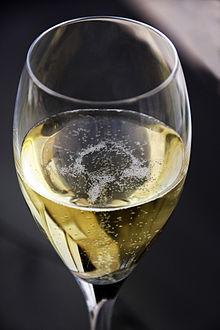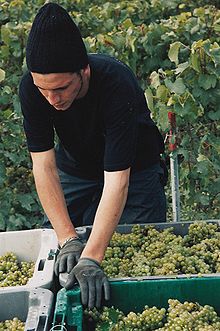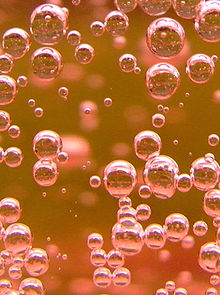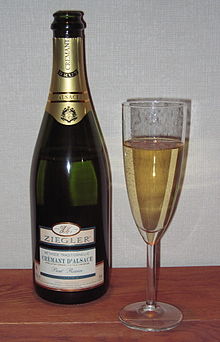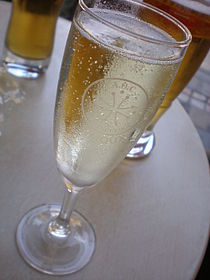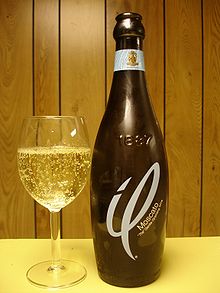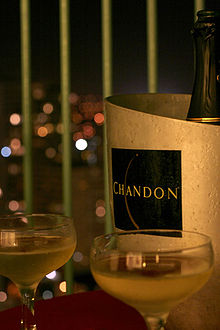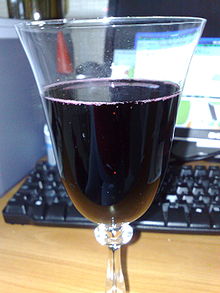- Sparkling wine
-
- Frizzante redirects here, for the racehorse, see Frizzante (horse).
Sparkling wine is a wine with significant levels of carbon dioxide in it making it fizzy. The carbon dioxide may result from natural fermentation, either in a bottle, as with the méthode champenoise, in a large tank designed to withstand the pressures involved (as in the Charmat process), or as a result of carbon dioxide injection.
Sparkling wine is usually white or rosé but there are many examples of red sparkling wines such as Italian Brachetto and Australian sparkling Shiraz. The sweetness of sparkling wine can range from very dry "brut" styles to sweeter "doux" varieties.[1]
The classic example of a sparkling wine is Champagne, but this wine is exclusively produced in the Champagne region of France and many sparkling wines are produced in other countries and regions, such as Espumante in Portugal, Cava in Spain, Franciacorta, Trento, Oltrepò Pavese Metodo Classico and Asti in Italy (the generic Italian term for sparkling wine being spumante) and Cap Classique in South Africa. Most countries reserve the word Champagne for a specific type from the Champagne region of France. The French terms "Mousseux" or "Crémant" are used to refer to sparkling wine not made in the Champagne region. German and Austrian sparkling wines are called Sekt. The United States is a significant producer of sparkling wine with producers in numerous states. Recently the United Kingdom, which produced some of the earliest examples of sparkling wine, has started producing sparkling wines again.
Contents
History
See also: History of ChampagneEffervescence has been observed in wine throughout history and has been noted by Ancient Greek and Roman writers but the cause of this mysterious appearance of bubbles was not understood. Over time it has been attributed to phases of the moon as well as both good and evil spirits. The tendency of still wine from the Champagne region to lightly sparkle was noted in the Middle Ages but this was considered a wine fault and was disdained in early Champagne winemaking.[2] Dom Pérignon was originally charged by his superiors at the Abbey of Hautvillers to get rid of the bubbles since the pressure in the bottles caused many of them to burst in the cellar.[3] Later, when deliberate sparkling wine production increased in the early 18th century, cellar workers would still have to wear a heavy iron mask that resembled a baseball catcher's mask to prevent injury from spontaneously bursting bottles. The disturbance caused by one bottle's disintegration could cause a chain reaction, with it being routine for cellars to lose 20-90% of their bottles to instability. The mysterious circumstance surrounding the then unknown process of fermentation and carbonic gas caused some critics to call the sparkling creations "The Devil's Wine".[4]
The British were the first to see the tendency of wines from Champagne to sparkle as a desirable trait and tried to understand why it produced bubbles. Wine was often transported to England in wooden wine barrels where merchant houses would then bottle the wine for sale. During the 17th century, English glass production used coal-fueled ovens and produced stronger, more durable glass bottles than the wood-fired French glass. The English also rediscovered the use of cork stoppers, once used by the Romans but forgotten for centuries after the fall of the Roman empire. During the cold winters of the Champagne region, temperatures would drop so low that the fermentation process was prematurely halted—leaving some residual sugar and dormant yeast. When the wine was shipped to and bottled in England, the fermentation process would restart when the weather warmed and the cork-stoppered wine would begin to build pressure from carbon dioxide gas. When the wine was opened, it would be bubbly. In 1662, the English scientist Christopher Merret presented a paper detailing how the presence of sugar in a wine led to it eventually sparkling and that by adding sugar to a wine before bottling it, nearly any wine could be made to sparkle. This is one of the first known accounts of understanding the process of sparkling wine and even suggests that British merchants were producing "sparkling Champagne" before the French Champenois were deliberately making it.[2]
Production
Main article: Sparkling wine productionThe viticultural and winemaking practices of making sparkling wine have many similarities to the production of still wine with some noted divergence. At the vineyard, grapes are harvested early when there is still high acid levels. In areas like Australia, winemakers aim to harvest the grapes at 17 to 20° brix. Unlike still wine production, high sugar levels are not ideal and grapes destined for sparkling wine production may be harvested at higher yields. Care is taken to avoid tannins and other phenolic compounds with many premium producers still choosing to harvest by hand rather than risk mechanical harvesting which may split the berries and encourage maceration between the skins and juice. The press house is often close by the vineyard to where the grapes can be quickly pressed and separated from their skins. Red wine grapes like Pinot noir can be used in the production of white sparkling wines because their juice is initially clear and is only later tinted red through exposure to the color pigments in grape skins. While some skin exposure maybe desirable in the production of rosé sparklers and some blanc de noirs (white of blacks), most sparkling wine producers take extended precautions to limit the amount of skin contact.[1]
The primary fermentation of sparkling wine begins like most other wines, though winemakers may choose to use specially cultivated sparkling wine yeasts. The wines may go through malolactic fermentation, though producers wishing to make fruitier, simpler wines will usually forgo this step. After fermentation the base wines are then blended to form a cuvee. While there are examples of varietal sparklers, such as blanc de blancs (white of whites) made from 100% Chardonnay, most sparkling wines are blends of several grape varieties, vineyards and vintages. Producers with wide access to grapes will use wines from several hundred base wines to create a blend that reflect the "house style" of their non-vintage wine. It is through the initiation of a secondary fermentation that distinguishes sparkling wine production and gives the wine its characteristic "bubbles". One of the by products of fermentation is the creation of carbon dioxide gas. While this gas is able to be released during the first fermentation, efforts are taken during the second fermentation to retain the gas and have it dissolve into the wine. This creates a massive amount of pressure within the wine bottle (on average around 5 atmospheres) and wine producers take care to package the wine in strong glass bottles. When the wine is open and poured into a glass, the gas is released and the wine becomes sparkling.[1]
Secondary fermentation
There are several methods used to carry out this secondary fermentation. The most well known is the Traditional or "Champagne method" where the base cuvee is bottled with a mixture of sugar and yeast. The introduction of a fresh yeast and food source (the sugar) triggers the fermentation process in the bottle that the wine will eventually be sold in. Through the process of riddling and eventually disgorgement, the dead yeast cells (lees) are removed from the wine while still maintaining the dissolved carbon dioxide gas. A dosage mixture of fresh wine and some sugar syrup is used to adjust the sweetness level of the wine after it has been disgorged. In the methode ancestrale the disgorgement step is skipped and the wine is sold with the lees still present as sediment in the wine. In the transversage method, after the wines have gone through the traditional method including riddling and disgorgement, the bottles are emptied into a large tank where they are then transferred to small and large format wine bottles such as 3 liter jeroboam and small split sizes used on airlines.[1] Numerous quality producers worldwide use the "Traditional" method to make their sparkling wines.
The Charmat method takes place in stainless steel fermentation tanks that are pressurized. The fresh yeast and sugar mixture is added to the wine which rapidly stimulates fermentation in the pressurized environment. The wine is then cooled, clarified and bottled using a counter pressure filler. The process of carbon injection (or carbonation), the method used to make soda pop fizzy, does not involve initiating a secondary fermentation but rather injecting carbon dioxide gas directly into the wine. This method produces large bubbles that quickly dissipate and is generally only used in the cheapest sparkling wines.[1]
Bubbles
See also: CarbonationAn initial burst of effervescence occurs when the sparkling wine contacts the dry glass on pouring. These bubbles may form on imperfections in the glass that facilitate nucleation or on cellulose fibres left over from the wiping/drying process.[5][6] Nucleations are needed to stimulate the formation of bubbles because carbon dioxide has to first diffuse from the wine solution before it can rise out of the glass and into the air. A poured glass of sparkling wine will lose its bubbliness and carbon dioxide gas much more quickly than an open bottle alone would.[7] The frothiness or "mousse" of the sparkler, along with the average size and consistency of the bubbles, can vary depending on the quality of the sparkler and the type of glass used.[1]
The average bottle of Champagne contains enough carbon dioxide to potentially produce 49 million bubbles.[8] (Wine expert Tom Stevenson puts the number at 250 million.[2]) The bubbles initially form at 20 micrometers in diameter and expand as they gain buoyancy and rise to the surface. When they reach the surface they are approximately 1 millimeter in size. It is speculated that the bubbles in sparkling wine may speed up alcohol intoxication by helping the alcohol to reach the bloodstream faster. A study conducted at the University of Surrey in the United Kingdom gave subjects equal amounts of flat and sparkling Champagne which contained the same levels of alcohol. After 5 minutes following consumption, the group that had the sparkling wine had 54 milligrams of alcohol in their blood while the group that had the same sparkling wine, only flat, had 39 milligrams.[8]
Sweetness
For more details about how these sweetness levels came to be, see History_of_Champagne#From_sweet_to_brut.The amount of sugar (dosage) added after the second fermentation and aging varies and will dictate the sweetness level of the sparkling wine. Wines produced within the European Union must include the sweetness level on the wine label. For wines produced outside the EU, the sweetness level is not required but if it is included on the label the terms used must conform to EU guidelines.[2]
- Brut Natural or Brut Zéro (fewer than 3 grams of sugar per litre)
- Extra Brut (fewer than 6 grams of sugar per litre)
- Brut (fewer than 12 grams of sugar per litre)
For more details about sweetness terms, see Sweetness_of_wine#Terms_used_to_indicate_sweetness_of_sparkling_wine.French sparklers
The most well known example of sparkling wine is that of Champagne from the Champagne wine region of France. On average, Champagne is responsible for about 8% of worldwide sparkling wine production with many other regions emulating the "Champagne style" in both grapes used (generally Chardonnay, Pinot noir and Pinot Meunier) and production methods—sometimes referred to as the "Champagne method". French sparklers made according to the Champagne method of fermentation in the bottle, but sometimes use different grape varieties, are known as Cremants and are governed under their own Appellation d'origine contrôlée (AOC) regulations. Another style of sparkling wine found in France are those made according to the methode ancestrale which skips the process of disgorgement and produces wines with slight sweetness and still containing the particles of dead yeast matter in the form of lees in the bottle. The regions of Gaillac, Limoux and Clairette de Die are the most well known producers of methode ancestrale wines.[1]
Champagne
Main article: Champagne (wine)Champagne is produced at the far extreme of viticultural circumstances, where the grape struggles to ripen in a long drawn out growing season. Cool climate weather limits the types of wine and grape varieties that can be made but it is in this region that sparkling wine has found its standard bearer. The limestone–chalk soil produces grapes that have a certain balance of acidity, extract and richness that is difficult to replicate in other parts of the world. The Champenois vigorously defend use of the term "Champagne" to relate the specific wine produced in the Champagne wine region. This includes objection to the term "Champagne style" to refer to sparkling wines produced outside the Champagne region. Since 1985, use of the term methode champenoise has been banned in all wines produced or sold in the European Union.[2]
Blending is the hallmark of Champagne wine, with most Champagnes being the assembled product of several vineyards and vintages. In Champagne there are over 19,000 vineyard owners, only 5,000 of which are owned by Champagne producers. The rest sell their grapes to the various Champagne houses, negociants and co-operatives. The grapes, most commonly Chardonnay, Pinot noir and Pinot meunier, are used to make several base wines that are assembled together to Champagne. Each grapes add their own unique imprint on the wine. Chardonnay is prized for its finesse and aging ability. Pinot noir adds body and fruit while Pinot meunier contributes substantially to the aroma adding fruit and floral notes. The majority of Champagne produced is non-vintage (or rather, multi-vintage) blends. Vintage Champagne is also produced, and this is often a house's most prestigious and expensive wine, but only in years when the producers feel that the grapes have the complexity and richness to warrant it.[2]
Crémant
Sparkling wines designated Crémant are produced using the traditional method, and have to fulfill strict production criteria.[9] In France, there are seven appellations for sparkling wine which include the designation Crémant in their name:
- Crémant d'Alsace
- Crémant de Bordeaux
- Crémant de Bourgogne
- Crémant de Die
- Crémant du Jura
- Crémant de Limoux
- Crémant de Loire
There is also a Crémant designation outside of France:
- Crémant de Luxembourg
French appellation laws dictate that a Crémant must be harvested by hand with yields not exceeding a set amount for their AOC. The wines must also be aged for a minimum of one year. The Loire Valley is France's largest producer of sparkling wines outside of the Champagne region. The majority of these Crémant de Loire are produced around the city of Saumur and are a blend of the Chardonnay, Chenin blanc and Cabernet franc. AOC laws do allow cuvées with Sauvignon blanc, Cabernet Sauvignon, Pinot noir, Gamay, Côt, Pineau d'aunis and Grolleau but those grapes are rarely used in a significant amount. In Burgundy, AOC laws require that Crémant de Bourgogne be composed of at least thirty percent Pinot noir, Chardonnay, Pinot blanc or Pinot gris. Aligoté is often used to fill out the remaining parts of the blend.[10] The Languedoc wine Crémant de Limoux is produced in the forty one villages around the village of Limoux in the south of France. The wine is composed primarily of the indigenous grape Mauzac with some Chenin blanc and Chardonnay. The wine must spend a minimum of one year aging on its lees. The sparkling Blanquette de Limoux is composed predominately of Mauzac and is aged for nine months.[11]
The designation Crémant was previously used for sparkling wines from the Champagne region which were produced with slightly less carbon dioxide and somewhat lower bottle pressure (typically 2-3 atmospheres instead of 5-6).[9] These wines were rare in comparison to regular, full-pressure Champagne. The Crémant designation was also used for sparkling wines from the Loire valley, in the form of Crémant de Saumur and Crémant de Vouvray, without being defined as separate appellations. In 1975, Crémant de Loire was given formal recognition as an AOC, and was followed by Crémant de Bourgogne (1975) and Crémant d'Alsace (1976). When in the late 1980s lobbying by Champagne producers led to méthode champenoise being forbidden within the European Union as a designation for the traditional method, the term Crémant was given its present definition. This meant that the use of "Crémant" in the Champagne region was discontinued and additional French Crémant AOCs were created from 1990, starting with Bordeaux and Limoux.
In Luxembourg, Crémant de Luxembourg is a designation within the Moselle Luxembourgeoise appellation, rather than a separate appellation, but otherwise follow the same rules as French Crémant.[12]
Since the designation Crémant is not reserved exclusively for French use (as a result of it replacing méthode champenoise), it may also be used by producers in other EU countries which fulfill the production criteria, although such usage is rare.
Other French sparkling wines
There are also some other French appellations for sparkling wines, which do not carry the name Crémant. Some of these are exclusively sparkling wine appellations, and some are appellations allowing both still and sparkling wine to be made. The term Mousseux is French for "sparkling" and can refer to a sparkling wine made using methods other than the méthode champenoise such as charmat method.[13] While Crémant can only be used for wines that have been made using the méthode champenoise.[14]
Sparkling-only are:
- Anjou mousseux AOC
- Blanquette de Limoux AOC
- Blanquette méthode ancestrale AOC
- Bourgogne mousseux AOC
- Clairette de Die AOC
- Saumur mousseux AOC
- Touraine mousseux AOC
Either still or sparkling are:
- Gaillac AOC
- Saint-Péray AOC
- Vouvray AOC
- Montlouis AOC
Other European sparklers
Cava
Main article: Cava (Spanish wine)Cava is the name of a type of Spanish (mostly in Catalonia but also in other regions such as Valencia, La Rioja, Extremadura) white or pink sparkling wine produced mainly in the Penedès region in Catalonia, 40 km to the south west of Barcelona, with the méthode champenoise but grape varieties different from grapes used in Champagne making. Cava is a Greek term that was used to refer to a "high end" table wine or wine cellar, and comes from the Latin word "cava" which means cave in English. Caves were used in the early days of Cava production for the preservation or aging of wine.[15] Today Cavas have become integrated with Catalan and also Spanish family traditions and is often consumed at any kind of celebrations (baptism, marriages, banquets, dinners and parties). The sparkling wine of Cava was created in 1872 by Josep Raventós. The vineyards of Penedès were devastated by the phylloxera plague, and the predominantly red vines were being replaced by large numbers of vines producing white grapes. After seeing the success of the Champagne region, Raventós decided to create the dry sparkling wine that has become the reason for the region's continued success. In the past the wine was referred to as Spanish Champagne (no longer permitted under EU law), or colloquially as champaña in Spanish or xampany in Catalan.[16]
Cava is produced in varying levels of dryness of the wine which are: brut nature, brut (extra dry), sec (in Catalan) seco (dry), semisec (in Catalan) semiseco (medium) and dolç (in Catalan) dulce (sweet). Under Spanish Denominación de Origen laws, Cava can be produced in six wine regions and must be made according to the Traditional Method with second fermentation in the bottle and uses a selection of the grapes Macabeu, Parellada, Xarel·lo, Chardonnay, Pinot noir, and Subirat. Despite being a traditional Champagne grape, Chardonnay was not used in the production of Cava until the 1980s.[16]
Portuguese sparklers
Espumante, pronounced esh-pu-man-te, is the Portuguese version of a sparkling wine. And unlike Cava, which is produced solely in northern climates, Espumante is not only produced in the northern wet region of Vinho Verde, but also throughout Portugal all the way to the southern region of the Alentejo, known for its extreme temperatures and arid climate.
While Spain has one regulating body, DOC Cava, spread across several different political regions, quality Espumante is produced solely in DOC Bairrada, located just south of Vinho Verde. In order for a wine to be certified as a quality Espumante from DOC Bairrada, it must be made in the traditional Champagne (indicating the year of harvest) and stamped with the VEQPRD (Vinho Espumante de Qualidade Produzido em Região Determinada) certification.
VFQPRD: is a regional sparkling wine made in the traditional champagne, charmat or transfer method in one of the following determined regions: Douro, Ribatejo, Minho, Alentejo or Estremadura.
VQPRD: is a sparkling wine that can made by injecting the wine with gas in the traditional champagne, charmat, transfer method anywhere in Portugal.
Espumosos: the cheapest and lowest level of sparkling wine, made by injecting the wine with CO2.
Top quality Espumantes can be found in Bairrada region and in Távora-Varosa sub region - Murganheira is a great example of high quality Espumante from this region.
Italian sparklers
According to etymological sources, the term "spumante" was not used in a wine context until 1908, more than 40 years following the first Italian sparkling wine using the méthode champenoise produced by Carlo Gancia which was then sold as "Moscato Champagne".[17]
Sparkling wines are made throughout Italy but the Italian sparklers most widely seen on the world market are the Franciacorta from Lombardy, Asti from Piedmont, Lambrusco from Emilia and Prosecco from Veneto. The Trento DOC is also famous. Though Franciacorta wines are made according to the traditional method, most Italian sparkling wines, in particular Asti and Prosecco, are made with the Charmat method.
Asti is a slightly sweet sparkler made from the Moscato grape in the province of Asti. The wine is noted for its low alcohol levels around 8% and fresh, grapey flavors. Moscato d'Asti is a frizzante style slightly sparkling version of Asti.[18]
The Franciacorta region, located northwest of Brescia, is home to the largest segment of Italian sparkling wine production. Made predominately from Chardonnay and Pinot bianco, sparklers labeled under the Franciacorta DOCG are permitted to include no more than 15% Pinot nero. Both vintage and non-vintage Franciacorta sparklers are made which require 30 and 18 months, respectively, of aging on the lees.[17][19] Franciacorta Satèn, a Blanc de blancs, is produced with the reduced 4.5 atmospheres of pressure instead of 6 for an expression of softness.[17]
Trento DOC is an appellation for white and rosé sparkling wines maded according to the méthode traditionnelle. Chardonnay, Pinot Noir, Pinot Blanc and Pinot Meunier grapes are used. There is a maximum vien yield of 150 q.l. per hectare for all varietals, and a maximum grape yield of 70%. The wines must rest for a minimum of 15 months on their lees for non-vintage, 24 months for vintage, and 36 for riserva. Minimum alcohol content must be of 11.5%, or 12% for riserva. Trento DOC wines are distinguished by their straw-yellow color.
Prosecco is made in both fully sparkling (spumante) and lightly sparkling (frizzante) styles. The wine is produced in the cool hills around the town of Valdobbiadene and are generally dry but sweeter examples are produced.[20]
v.f.q.p.r.d. (Vini Frizzanti di Qualità Prodotti in Regioni Determinate): Quality Vini frizzanti made within defined regions are generally labeled as such.
Sekt
Sekt is the German term for quality sparkling wine. The majority of Sekt produced (around 95%) is made by the Charmat method with the remaining premium Sekt being made according to the méthode traditionnelle. Cheap sparkling wine made with CO2 injection must not be called Sekt, but rather Schaumwein (German for sparkling wine, literally "foam wine"), semi-sparkling wine is called Perlwein. Around 90 percent of Sekt is made at least partially from imported wines from Italy, Spain and France. Sekt labeled as Deutscher Sekt is made exclusively from German grapes, and Sekt b.A. (bestimmter Anbaugebiete, in parallel to Qualitätswein b.A.) only from grapes from one of the 13 quality wine regions in Germany.
Some of the premium wines are often made using the Riesling, Pinot blanc, Pinot gris and Pinot noir grapes, with much of it drunk locally rather than exported. These Sekts are usual vintage dated with the village and vineyards that the grapes are from.[21] Premium Sekt b.A. produced in smaller lots is often referred to as Winzersekt (winegrower's Sekt), since it is typically produced by a producer which has vineyards of his own, rather than by the large Sekt-producing companies (Sektkellereien) which buy grapes or base wine on a large scale for their production. In Austria, the corresponding term is Hauersekt.
German production of sparkling wines dates back to 1826, when G. C. Kessler & Co. was founded in Esslingen am Neckar by Georg Christian Kessler (1787–1842), who had previously worked at the Champagne house Veuve Clicquot from 1807 to 1826. The names used by the German producers for their sparkling wines in the 19th century were "Mousseux", "Sect" or "Champagne" (or Champagner), but the 1919 Treaty of Versailles forbade Germany the use of this name, long before European Union regulations prohibited its use outside the Champagne region. Sekt was initially an informal German name for sparkling wine, coined in Berlin 1825, but was in common use by the 1890s. Germany long attempted to have the name Sekt reserved for sparkling wine from countries with German as an official language, but these regulations were annulled by the European Court of Justice in 1975. Another legal decision in the 1970s abolished the large producers' monopoly on Sekt production, allowing winemaking cooperatives and individual winegrowers to produce and sell their own sparkling wines. Together, these two decision produced the situation of the name Sekt being possible to apply to sparkling wines of varying quality level.
Sekt typically comes with elaborate enclosure (safety cage) to withstand its considerable CO2 pressure. It also comes with a Schaumwein tax, which since 2005 has been 136 euro per hectoliter, corresponding to 1.02 euro per 0.75 liter bottle.[22] This tax was famously introduced by Emperor Wilhelm II in 1902 to fund the expansion of the Imperial Navy.
Germans also call some similar foreign wines Sekt, like Krimsekt (often red) from Crimea.
In Austria, Sekt is often made in the méthode champenoise with the Welschriesling and Grüner Veltliner grapes giving the wine a golden hue color. Sparkling rosé are made from the Blaufränkisch grape.[21] Austria's history of producing sparkling wine dates back to the Austro-Hungarian empire. Most Austrian Sekt producers are based in Vienna and source their grapes from the Weinviertel region in Lower Austria. Like its German counterpart, Austrian Sekt can be made trocken (dry) or halbtrocken (medium dry).[23]
The first Austrian producer of sparkling wine was Robert Alwin Schlumberger, who presented his first sparkling wine in 1846 under the name Vöslauer weißer Schaumwein (White sparkling wine of Vöslau). It was produced from Blauer Portugieser grapes growing in vineyards in Bad Vöslau which Schlumberger bought in 1843, and the sparkling wine was an immediate success. Stuttgart-born Schlumberger had worked in the Champagne house Ruinart before he moved to Vienna in 1842.[24]
Pezsgő
The Hungarian equivalent for sparkling wine is ’pezsgő’. The beginning of significant sparkling wine production in Hungary is dated back to the first half of the 19th century. The first wineries of sparkling wine were founded near Pozsony (today Bratislava) by Hubert I.E. 1825 (first in Central-Europe) and Esch és Társa in 1835. A couple of decades later the main producers moved to the Budai mountains and Budafok nearby the capital creating a new center of production, the so-called ’Hungarian Champagne’ existing till nowadays. At the end of the 19th century the two most important wineries were József Törley és Társa moving from Reims, France to Budafok in 1882 and Louis és César-François founded in 1886. After the Soviet era the Hungarian wine sector was reborn. New and old wineries are seeking for the forgotten roots. Most of the Hungarian sparkling wines are made by the charmat and transvasée methods and a small but steadily growing amount by the traditional, champagneois method. The sorts of grape used during production can be international like Chardonnay, Pinot noir, Riesling, Muscat Ottonel, Muscat Lunel or natives like Olaszrizling, Kékfrankos, Furmint, Királyleányka, Hárslevelű, Kéknyelű and Juhfark.[25]
Sovetskoye Shampanskoye
In the Soviet Union, sparkling wine was produced under the name Soviet Champagne, or Sovetskoye Shampanskoye, most of it sweet. This designation continues to be used for sparkling wine produced in several countries formerly part of the Soviet Union, including Moldova, Armenia, Belarus, Russia and Ukraine. Most likely, the name has stuck since Sovetskoye Shampanskoye was one of the few products or brands of the Soviet era which were seen as luxurious. Nowadays, it is more common to encounter Sovetskoye Shampanskoye produced in a dry style, although a Moldovan made semi-sweet version from Muscat grapes has been regularly available in the U.S.
Romanian sparklers
In Romania, sparkling wine is mostly made in Panciu. Located on the right side of the Zabrautului valley, in a place called Cerbului Valley, Panciu Cellars were built in loess soil, and consist of a central corridor that gives off a total of 36 branching galleries along its side, totalling almost 3,000 m. The Cellars belong to the era of Stephen the Great and Saint (1457–1504). From a documentary point of view, the cellars are certified in the late 18th century, in an act of August 19, 1700 mentioning how to use and their owners - Ioan Costin, son of the great Lord Miron Costin. Legends and mystery surrounding hills planted with vines around-the-city of Panciu ever since Burebista. The ancient Thracians, a people known for ingenuity and attraction towards the underground construction, inhabited the area in antiquity. About this region, some historians say that it was the ancient capital of Thrace, the ancient inhabitants of these places built underground cellars for an initial network of tortuous defence. Their length was impressive network of galleries stretching, according to hypotheses circulated by specialists, for tens of kilometers, up to Magura Odobesti. Later, they became the perfect hiding place against foreign invasions, in World War the cellars from Panciu being used to shelter local people from enemy bombs. The Cellars Steven the Great are historical monuments and UNESCO heritage, and are managed by Veritas Panciu since 1949. Here is produced by the classical method Champenoise best champagne - champagne Panciu.
English sparklers
Commercial production of bottle fermented sparkling wines from grapes grown in England started in the 1960s, although there has been a longer history of sparkling wines made in the UK from imported grapes. In the 1980s, some English winemakers started to grow the grape varieties as used in Champagne - Chardonnay, Pinot Noir and Pinot Meunier - and in the ensuing decades availability of English sparkling wines made from these varieties increased. Today, there are over 100 vineyards in England producing sparkling wines with Nyetimber, Ridgeview and Chapel Down being some of the largest producers.[26] In 2010, Chardonnay and Pinot Noir were the two most commonly planted grape varieties in English vineyards. Along with Pinot Meunier, the three varieties combined accounted for around 40% of vines planted, which appears to reflect a significant growth in interest in English sparkling wines. To put that in context, the current yield for all types of English wine averages to around 2 million bottles annually.[27]
New World sparklers
American sparkling wines
Sparkling wines produced in the United States can be made in both the méthode champenoise and the charmat method. Lower cost sparklers, such as André, Cook's, and Tott's, often employ the latter method while more premium sparkling wines utilizing the former. The history of producing quality sparkling wine in California can be traced to the Sonoma Valley where, in 1892, the Korbel brothers (immigrated from Bohemia in 1852) began producing sparkling wine according to the méthode champenoise. The first wines produced were made from Riesling, Muscatel, Traminer and Chasselas grapes. Partly aided by the foreign influence, the overall quality of Californian sparklers increased with the introduction of the more traditional sparkling wine grapes of Chardonnay, Pinot noir, Pinot Meunier and Pinot blanc into the production. US AVA requirements and wine laws do not regulate the sugar levels and sweetness of wine though most producers tend to follow European standards with Brut wine having less than 1.5% sugar up to Doux having more than 5%. As the sparkling wine industry in California grew, foreign investments from some of the Champagne region's most noted Champagne houses came to set up wineries in the area. These include Moët et Chandon's Domaine Chandon, Louis Roederer's Roederer Estate, and Taittinger's Domaine Carneros.[28]
While many top American sparkling wine producers utilize the traditional methods of production, there are distinct differences in their wine making techniques that have a considerable effect on the taste of the wines. In Champagne, the cuvée blend will rarely have less than 30 wines and sometimes as many as 60 that are taken from grapes spanning 4–6 years of different vintages. In California, cuvees are typically derived from around 20 wines taken from 1 to 2 years worth of vintages. Champagne laws require that the wine spend a minimum of 15 months on the lees for non-vintage and minimum 3 years for vintage Champagne. It is not uncommon for a premium Champagne to age for 7 years or more prior to release. In the US, there are no minimum requirements, and aging length can vary from 8 months to 6 years. Another distinct difference, particularly in Californian sparkling wines, is the favorable Californian climate which allows a vintage wine to be produced nearly every year.[28]
Current US regulations ban the use of the term "Champagne" on any wines not produced in Champagne except if the label was in use before 2006. No new labels including the term "Champagne" will be approved by the US Government for wines produced outside of the Champagne region of France after 2006. Those "grandfathered labels" can only use the term on a wine label if there appears next to that name the appellation of "the actual place of origin".[29]
The growth of the Finger Lakes wine industry in New York State and the success of Riesling wines from the region has resulted in an increasing number of producers such as Swedish Hill Vineyards making méthode champenoise sparkling wines from primarily or 100% Riesling. [30] Finger Lakes producers such as Glenora and Casa Larga are also producing méthode champenoise sparkling wine from other grapes such as the traditional Chardonnay and Pinot Noir.
Australia
Australian sparkling wine can be produced using the Charmat method or the traditional method, and can be vintage dated or a multivintage blend.[31] Most sparkling wine is produced from Chardonnay and Pinot noir, but an Australian speciality is Sparkling Shiraz, a red sparkling wine produced from Shiraz grapes. Most sparkling Shiraz is traditionally somewhat sweet, but some producers make it dry, full-bodied and tannic.
South Africa
Methode Cap Classique denotes a South African sparkling wine made by the traditional Champagne method. Sauvignon blanc and Chenin blanc have been the traditional Cap Classique grapes but the use of Chardonnay and Pinot noir have been on the increase.[32] Sparkling wine is also made according to the with both the Charmat method and red sparkling Pinotage can also be found.[33]
Semi-sparkling wines
Fully sparkling wines, such as Champagne, are generally sold with 5 to 6 atmospheres of pressure in the bottle. This is nearly twice the pressure found in an automobile tire. European Union regulations define a sparkling wine as any wine with an excess of 3 atmospheres in pressure. These include German Sekt, Spanish Espumoso, Italian Spumante and French Cremant or Mousseux wines. Semi-sparkling wines are defined as those with between 1 and 2.5 atmospheres of pressures and include German spritzig, Italian frizzante and French pétillant wines. The amount of pressure in the wine is determined by the amount of sugar added during the tirage stage at the beginning of the secondary fermentation with more sugar producing increased amount of carbon dioxide gas and thus pressure in the wine.[7]
Red sparkling wines
While the majority of sparkling wines are white or rosé, Australia, Italy and Moldova all have a sizable production of red sparkling wines. In Australia, these sparklers are often made from the Shiraz grape.[34]
References
- ^ a b c d e f g J. Robinson (ed) "The Oxford Companion to Wine" Third Edition pg 656-660 Oxford University Press 2006 ISBN 0198609906
- ^ a b c d e f T. Stevenson, ed. The Sotheby's Wine Encyclopedia (4th Edition) pg 169-178 Dorling Kindersley 2005 ISBN 0751337404
- ^ D. & P. Kladstrup Champagne pg 25 Harper Collins Publisher ISBN 0060737921
- ^ D. & P. Kladstrup Champagne pp 46-47 Harper Collins Publisher ISBN 0060737921
- ^ (French) G. Liger-Belair (2002). "La physique des bulles de champagne". Annales de Physique 27 (4): 1–106. http://www.edpsciences.org/articles/anphys/abs/2002/04/ann042002/ann042002.html.
- ^ G. Liger-Belair et al. (2002). "Close-up on Bubble Nucleation in a Glass of Champagne" (PDF). American Society for Enology and Viticulture 53 (2): 151–153. http://www.asev.org/Journal/Volumes/53_2/Pgs151-153%20Abstract.pdf. PDF abstract
- ^ a b J. Robinson (ed) "The Oxford Companion to Wine" Third Edition pg 272-273. Oxford University Press 2006 ISBN 0198609906
- ^ a b G. Harding "A Wine Miscellany" pg 136-137, Clarkson Potter Publishing, New York 2005 ISBN 0307346358
- ^ a b Oxford Companion to Wine, 2nd Edition (1999): Crémant
- ^ K. MacNeil The Wine Bible pg 207, 267-268 Workman Publishing 2001 ISBN 1563054345
- ^ K. MacNeil The Wine Bible pg 302 Workman Publishing 2001 ISBN 1563054345
- ^ Institut Viti-Vinicole Grand Duché de Luxembourg: Cremant, accessed on April 1, 2008
- ^ J. Robinson (ed) "The Oxford Companion to Wine" Third Edition pg 460 Oxford University Press 2006 ISBN 0198609906
- ^ J. Robinson (ed) "The Oxford Companion to Wine" Third Edition pg 209 Oxford University Press 2006 ISBN 0198609906
- ^ J. Robinson (ed) "The Oxford Companion to Wine" Third Edition pg 143-144 Oxford University Press 2006 ISBN 0198609906
- ^ a b K. MacNeil The Wine Bible pg 455-460 Workman Publishing 2001 ISBN 1563054345
- ^ a b c Stevenson, Tom, The World of Fine Wine (June, 2008). "Savor: Franciacorta de Meglio in Meglio" (PDF). http://www.jeremyparzen.com/publications/franciacorta.pdf.
- ^ M. Ewing-Mulligan & E. McCarthy Italian Wines for Dummies pg 61-62 Hungry Minds 2001 ISBN 0764553550
- ^ M. Ewing-Mulligan & E. McCarthy Italian Wines for Dummies pg 95-98 Hungry Minds 2001 ISBN 0764553550
- ^ M. Ewing-Mulligan & E. McCarthy Italian Wines for Dummies pg 129-130 Hungry Minds 2001 ISBN 0764553550
- ^ a b K. MacNeil The Wine Bible pg 528-529, 583 Workman Publishing 2001 ISBN 1563054345
- ^ Bundesministerium der Justiz: Gesetz zur Besteuerung von Schaumwein und Zwischenerzeugnissen, § 2 Steuertarif, accessed on May 17, 2008
- ^ J. Robinson (ed) "The Oxford Companion to Wine" Third Edition pg 620 Oxford University Press 2006 ISBN 0198609906
- ^ Wein-Plus Glossar: Schlumberger, accessed on January 3, 2009
- ^ Gábor Rohály (ed) "Magyar Bor Könyve" pg 94-97, Akó press 2001, ISBN 9630077299 (Hungarian)
- ^ United Kingdom Vineyards Association
- ^ UK Food Standards Agency, Wine Standards Branch
- ^ a b K. MacNeil The Wine Bible pg 652-655 Workman Publishing 2001 ISBN 1563054345
- ^ US Code Collection [Section 5388(c) of Title 26 of the United States Code "Section 5388(c) of Title 26 of the United States Code"], Cornell University Law School. Accessed: January 11, 2011
- ^ http://www.chronicle-express.com/news/business/x279156168/Governors-Cup-goes-to-Swedish-Hill-Riesling-Cuvee
- ^ Wine Australia: Sparkling wine, accessed on January 3, 2009
- ^ K. MacNeil The Wine Bible pg 822 Workman Publishing 2001 ISBN 1563054345
- ^ T. Stevenson "The Sotheby's Wine Encyclopedia" pg 442-448 Dorling Kindersley 2005 ISBN 0756613248
- ^ K. MacNeil The Wine Bible pg 790 Workman Publishing 2001 ISBN 1563054345
industrial process of wine making at Veuve Ambal
Categories:- Sparkling wines
- Wine terms
Wikimedia Foundation. 2010.

